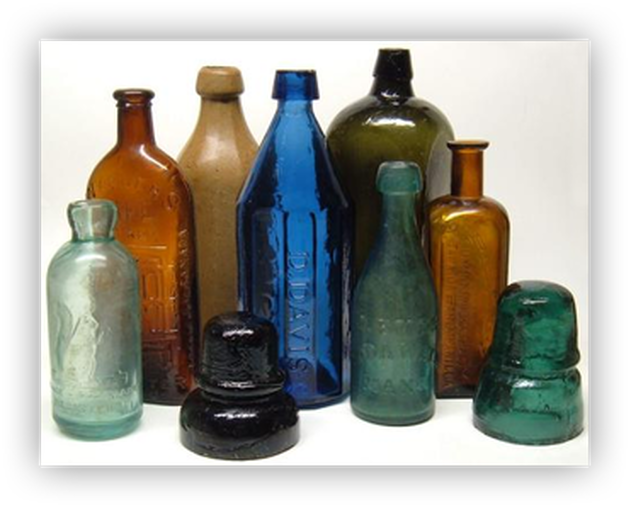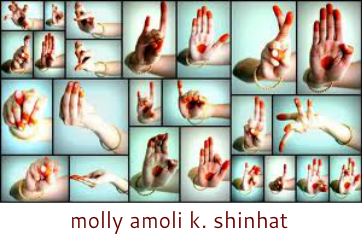Glass Works
The Story of Glass & Glass-making in Canada
Canadian Museum of Civilization

Image copyright Southwestern Ontario Antique Bottle Club, www.ecbw.ca
"When I was a kid, about 10 or 12 years old, some friends and I stumbled on an old village that had been occupied by Chinese workers out in BC," just outside Victoria, says Dr. David Gray, independent curator and research associate of the Canadian Museum of Civilization (CMC).
"Many of these bottles were slightly deformed because they'd been hand-blown. There were bubbles in them," he adds. "(They were of) different colours and from all over the world—the Philippines, a bottle from Europe, things from China, the States, and local stuff made in our own home town." Most were ceramic pots and alcohol bottles already around 80 years old.
"That sort of opened my eyes to glass as a historic item," he says. "And my interest has been sustained by that early exposure." Going on to work as an Arctic biologist, Dr. Gray never lost his fascination with glass.
"As a medium, it's made of naturally formed, naturally occurring materials," he explains, "So you don't have to be in a specific geographic location to make it, and it's easy to make. And it'll take any shape you want it to. Once you've made something out of glass it's very durable - it doesn't react with its contents. It can be molded into any kind of shape, made into any kind of form."
This relatively small exhibition—which includes a recipe for making glass - seems almost hidden on the fourth floor of the CMC. Its gleaming multi-coloured objects can just be seen past the expansive doll exhibit.
Given the equally diminutive size of the objects themselves however, Canadian glass of almost any description, colour, size, shape and antecedent makes an appearance: Vaseline glass, milk glass, cranberry glass, toy cars, scientific instruments, marbles, Depression glass, even tableware made with a Maple Leaf design, unique to Canada.
But this is far more than a collection of pretty objets de verre.
Thematically divided, for the most part according to where or how the glass was used—e.g. sacred, industrial, domestic- the exhibit features a tribute to CMC's primary glass collector, the late Elizabeth Shute. Alongside a heavy lead-crystal candelabra from the early 1800s, just one of her many acquisitions, her books and papers lie across a desk. As with some others, the size of this display case makes viewing objects near the back a little difficult.
A case of historic glass includes perfume bottles once owned by Isabella, John A. MacDonald's wife. Dating from around 1850, Parisian landmarks painted in tiny miniatures adorn each lid of the dark amber coloured bottles. The same case holds other surprises.
"Messages in a bottle were something that I always searched for as a kid," says Dr. Gray. "I knew there were things (in the CMC collections) from Arctic caches. I was kind of excited when I first saw it! In some cases if I had not been to that site, I'd been in the neighbourhood or read the journals of the people involved."
Described simply as "Bottle containing messages left by Whalers at Port Leopold, NWT, in 1888 and 1891, collected during the Canadian Arctic Expedition of 1907", the small approximately 4" high clear glass bottle complete with stopper, survives with its label. The notes inside, both carefully preserved in a see-through plastic envelope can still be partially read. On one, I could just make out, "July 91 - Black whale, 50 walruses".
Whether it actually bobbed atop waves somewhere didn't matter to me. Surely the very notion of a message in a bottle must be ancient and universal, particularly for people who live near the sea. To simply see a real-life example, a historical one to boot, was the ticket back to many childhood imaginings for me.
Designers' ingenuity, the objects' beauty and early examples of now common glass objects make for an absorbing exhibition. In addition to a battered mariner's compass, the exhibit includes ethereal glowing Carnival glass, an early Edison light bulb, a bead curtain, and sheets of advertising glass. Examples of simple mundane objects go well beyond the expected, a mustard container for example. A promotional series for "Lucky Joe Bank, Nash's Prepared Mustard," a remarkable forerunner of today's banal teddy bear peanut butter jars features a heavily lined human face.
By emphasizing the historical, the exhibit gives the impression that the "golden age" of glass is long gone. But Dr. Gray disagrees.
"Glass is still very important structurally in terms of windows and in terms of other components of building," he says. "It's not a static thing. New kinds of glass are being developed all the time," particularly in space and communications technologies.
"But that village where we found the glass (in the fifties) is still one of my research projects today," he adds. "Lots of the bottles have been given to museums, but I still have a few samples."
Published in The Ottawa Xpress, November 2001
"Many of these bottles were slightly deformed because they'd been hand-blown. There were bubbles in them," he adds. "(They were of) different colours and from all over the world—the Philippines, a bottle from Europe, things from China, the States, and local stuff made in our own home town." Most were ceramic pots and alcohol bottles already around 80 years old.
"That sort of opened my eyes to glass as a historic item," he says. "And my interest has been sustained by that early exposure." Going on to work as an Arctic biologist, Dr. Gray never lost his fascination with glass.
"As a medium, it's made of naturally formed, naturally occurring materials," he explains, "So you don't have to be in a specific geographic location to make it, and it's easy to make. And it'll take any shape you want it to. Once you've made something out of glass it's very durable - it doesn't react with its contents. It can be molded into any kind of shape, made into any kind of form."
This relatively small exhibition—which includes a recipe for making glass - seems almost hidden on the fourth floor of the CMC. Its gleaming multi-coloured objects can just be seen past the expansive doll exhibit.
Given the equally diminutive size of the objects themselves however, Canadian glass of almost any description, colour, size, shape and antecedent makes an appearance: Vaseline glass, milk glass, cranberry glass, toy cars, scientific instruments, marbles, Depression glass, even tableware made with a Maple Leaf design, unique to Canada.
But this is far more than a collection of pretty objets de verre.
Thematically divided, for the most part according to where or how the glass was used—e.g. sacred, industrial, domestic- the exhibit features a tribute to CMC's primary glass collector, the late Elizabeth Shute. Alongside a heavy lead-crystal candelabra from the early 1800s, just one of her many acquisitions, her books and papers lie across a desk. As with some others, the size of this display case makes viewing objects near the back a little difficult.
A case of historic glass includes perfume bottles once owned by Isabella, John A. MacDonald's wife. Dating from around 1850, Parisian landmarks painted in tiny miniatures adorn each lid of the dark amber coloured bottles. The same case holds other surprises.
"Messages in a bottle were something that I always searched for as a kid," says Dr. Gray. "I knew there were things (in the CMC collections) from Arctic caches. I was kind of excited when I first saw it! In some cases if I had not been to that site, I'd been in the neighbourhood or read the journals of the people involved."
Described simply as "Bottle containing messages left by Whalers at Port Leopold, NWT, in 1888 and 1891, collected during the Canadian Arctic Expedition of 1907", the small approximately 4" high clear glass bottle complete with stopper, survives with its label. The notes inside, both carefully preserved in a see-through plastic envelope can still be partially read. On one, I could just make out, "July 91 - Black whale, 50 walruses".
Whether it actually bobbed atop waves somewhere didn't matter to me. Surely the very notion of a message in a bottle must be ancient and universal, particularly for people who live near the sea. To simply see a real-life example, a historical one to boot, was the ticket back to many childhood imaginings for me.
Designers' ingenuity, the objects' beauty and early examples of now common glass objects make for an absorbing exhibition. In addition to a battered mariner's compass, the exhibit includes ethereal glowing Carnival glass, an early Edison light bulb, a bead curtain, and sheets of advertising glass. Examples of simple mundane objects go well beyond the expected, a mustard container for example. A promotional series for "Lucky Joe Bank, Nash's Prepared Mustard," a remarkable forerunner of today's banal teddy bear peanut butter jars features a heavily lined human face.
By emphasizing the historical, the exhibit gives the impression that the "golden age" of glass is long gone. But Dr. Gray disagrees.
"Glass is still very important structurally in terms of windows and in terms of other components of building," he says. "It's not a static thing. New kinds of glass are being developed all the time," particularly in space and communications technologies.
"But that village where we found the glass (in the fifties) is still one of my research projects today," he adds. "Lots of the bottles have been given to museums, but I still have a few samples."
Published in The Ottawa Xpress, November 2001

